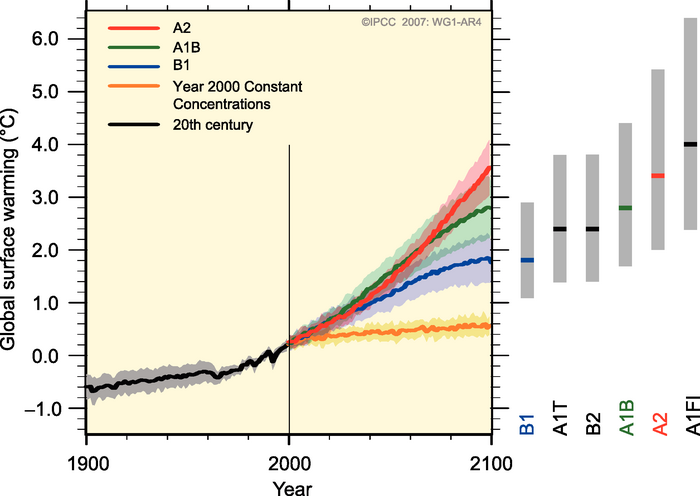Monckton, on the other hand, is calculating how much surface warming remains "in the pipeline" from the CO2 we've already emitted, due to the thermal lag of warming the oceans, and the fact that there is still a planetary energy imbalance. We can calculate this by instead plugging in the current CO2 concentration (390 ppm) into the formula above:
dT = 0.8*5.35*ln(390/280) = 1.4°C
Since the surface air has warmed about 0.8°C above pre-industrial levels thus far, there remains approximately 0.6°C warming "in the pipeline" from the CO2 we've emitted to this point, roughly consistent with Monckton's calculations (0.7°C).
So to this point, aside from a misunderstanding as to what Steketee was arguing, we're all in agreement!
All Good Things Must Come to an End
Unfortunately, Monckton doesn't quit while he's ahead, and continues:
"However, various climate extremists have published papers saying that equilibrium warming will not occur for 1000 years....The IPCC itself only expects about 57% of equilibrium warming to occur by 2100....Bottom line, then: by 2100 we can expect not 2 C° of further “global warming” as a result of our emissions so far, but 0.4 C° at most."
Did you spot the glaring error in this argument? Monckton has simply multiplied the 0.7°C warming he estimated "in the pipeline" by 0.57. Of course, the 0.7°C in the pipeline is based on the current atmospheric CO2 concentration, not the concentration in 2100! Monckton appears to be confusing the equilibrium temperature we will eventually reach based on today's CO2 levels with the temperature the planet will reach in the year 2100, which will depend on atmospheric CO2 changes between now and then.
As long as the atmospheric CO2 concentration doesn't increase over the next 90 years, Monckton is correct. Making that happen, however, would require a radically rapid reduction in human CO2 emissions. It would basically require that everyone everywhere stops using electricity and driving cars immediately. Simply put, it's completely unrealistic, and Monckton is wrong. The fact that we're already committed to 1.4°C of surface warming highlights how important it is to start reducing our greenhouse gas emissions immediately.
IPCC Reality is not Pretty
Monckton has also made a questionable statement about the equilibrium warming to occur by 2100, according to the IPCC. Let's examine IPCC Scenarios A1F1, A2, and B1, which correspond to atmospheric CO2 levels of approximately 950, 850, and 600 ppm in 2100. Here are the corresponding IPCC projected surface temperature changes:

Figure 1: Projected global surface warming from 2000 to 2100 in various IPCC scenarios
We can estimate the equilibrium surface temperature changes (?Teq) in each scenario by plugging the atmospheric CO2 levels into the formulas above, and compare to the IPCC projected temperature change by 2100:
Table 1: Percent of Equilibrium Temperature Change by 2100 in 3 IPCC Scenarios

As you can see, according to the IPCC, for these three emissions scenarios, between 75% and 90% of the equilibrium warming will occur by 2100. These numbers are consistent with the IPCC report itself (Chapter 10 of WGI), which estimates that approximately 80% of the equilibrium warming will be realized by 2100.
Monckton's claim of 57% of equilibrium warming being realized by 2100 appears to be inconsistent with the actual IPCC projections. It's worth noting that CO2 isn't the only factor to change in these scenarios. For example, global methane emissions rise much more in Scenarios A1F1 and A2 than B1, which helps explain the relatively smaller fraction of equilibrium warming experienced in Scenario B1 by 2100. It's also worth noting that equilibrium temperature change calculations are only realized when we manage to stabilize atmospheric CO2 concentrations.
Long-Term Climate Sensitivity
One final flaw in Monckton's argument is that the IPCC equilibrium climate sensitivity value is based on relatively fast-acting feedbacks. A 2008 study led by James Hansen found that climate sensitivity to "fast feedback processes" for a doubling of atmospheric CO2 is 3°C, but when accounting for longer-term feedbacks (such as ice sheet disintegration, vegetation migration, and greenhouse gas release from soils, tundra or ocean), if atmospheric CO2 remains at the doubled level, the sensitivity increases to 6°C based on paleoclimatic (historical climate) data. This long-term climate sensitivity is more appropriate in the timeframe (1,000+ years) Monckton references.
So Close, Yet Still So Wrong
Ultimately, while Monckton started out well in his calculation of the amount of "warming in the pipeline", he proceeded to make a fatal error by assuming that atmospheric CO2 levels will not increase over the next 90 years. This is a particularly significant error considering that Monckton would prefer that we continue in a business-as-usual scenario which will lead to atmospheric CO2 levels more than doubling over the next 90 years.
 As part of an ongoing series looking at Christopher Monckton’s response to Mike Steketee and as a new addition to the Monckton Myths, this post examines Monckton’s arguments about the amount of warming remaining "in the pipeline" from the CO2 we've already emitted. Monckton's point #23 in response to Steketee is mainly a misunderstanding of Steketee's argument:
As part of an ongoing series looking at Christopher Monckton’s response to Mike Steketee and as a new addition to the Monckton Myths, this post examines Monckton’s arguments about the amount of warming remaining "in the pipeline" from the CO2 we've already emitted. Monckton's point #23 in response to Steketee is mainly a misunderstanding of Steketee's argument:


